Don't wanna be here? Send us removal request.
Text
Before we get into black holes, there are a few myths about them that deserve to be addressed.
First off, they don’t “suck stuff in.” They exert gravity on objects the same as anything else with mass. In fact, if our sun were to be magically replaced, instantly, with a black hole of equal mass, our orbit around it wouldn’t change at all!
Second, that they’re black because their gravitational pull is so large that not even light can escape. This one’s more complicated. Around the singularity, there is a region of space where an observer cannot see “in”, which is called the event horizon. If you’re curious, this region’s size is defined by the black hole’s “Schwarzchild Radius” (Rs), which is defined by the equation Rs = 2GM / (c^2) where G is the gravitational constant, M is the mass of the black hole, and c is the speed of light.
In simple terms, let’s say we send an astronaut into the black hole. As they approach the event horizon, they experience time passing normally. From their perspective, they fall toward the black hole, through the event horizon, and observe whatever is happening beyond it. But from our perspective as an observer, the astronaut appears to slow down. Gravity affects spacetime, and the farther down a gravity well one goes, the slower time moves. This is actually something that GPS satellites need to account for, because this difference is observably present even for Earth’s gravity!
So as observers, the astronaut’s progress continues to slow as they approach the event horizon, to the point that their progress appears to just stop when they arrive at the edge of it. This is where the astronaut will appear to be, forever…if we could still see them. Light is also affected: it appears to slow down too and its frequency decreases. This decrease of its frequency is called redshift, and as the light approaches the event horizon it redshifts out of observable frequencies. So the astronaut, and the light with which we’d observe them, disappear without ever passing the event horizon from our perspective as observers. Remember, from the astronaut’s perspective they’re moving as normal and they pass through the event horizon just fine. So while, yes light can’t escape the event horizon, we’d never see it pass into it in the first place, and that’s why black holes appear black.
The last misconception, which I’m guilty of spreading in my last post, is that all black holes are infinitely dense. This is true in some cases, but supermassive black holes can actually have very low density! When I can find a satisfying answer as to why, I will be sure to share it lol.
This has become another one of my Very Long Posts, so if you would rather absorb this information in video or audio format, PBS Space Time has an excellent video here which I found very helpful in my understanding. All the material I’ve covered in this post is in this video, actually.
2K notes
·
View notes
Text
Math
Geologist: I do more math than you might think
Chemist: I mean, chemical equations are basically mathematical equations. If you think about it (I also do math math)
Physicist: Oh, yeah, it’s all math but we just handwave it
Mathematician: YOU DO WHAT!?
Quantum Physicist: *regularly does math that is literally beyond human comprehension* *now resides in a higher plane of existence*
Engineer: If I don’t do this math correctly PEOPLE WILL DIE
Military Scientist: If I don’t do this math correctly PEOPLE WILL SURVIVE
Topologist: If I don’t do this math correctly PEOPLE WILL BE MOSTLY UNAFFECTED
Philosopher: But what even IS math, really? No seriously, what is it?
Organic Chemist: I kinda forgot how to do math, to be honest
Biologist: I literally only chose this field so I wouldn’t have to do as much math. I love stamp collecting
Biostatistician: wtf
2K notes
·
View notes
Text
Propaganda:
Gravity - She’s reality’s failgirl. Weaker than the weak force; so pathetic you barely even notice her unless you’ve got a planetary object. But watch out! Unlike electromagnetism, she’s smart enough not to cancel herself out with silly things like “positive and negative charges,” so she has a surprisingly big impact in places like “outer space” and “the inside of black holes.” (What is she doing in there? No one knows!)
Electromagnetism - The most charismatic of the fundamental forces, she can be whatever you want her to be. You want light? She’s on it. Lightning? No problem. She holds molecules together and makes all life on Earth possible—not to mention cookie clicker. And all other computers, I guess. I truly believe she can do anything. She should run for president.
The Strong Force - The name isn’t ironic! Sure, electromagnetism holds molecules together—but who holds atoms together? That’s right, it’s Ms. Strong Force. She’s a real powerhouse, but wildly under-appreciated… mostly because she’s just so good at her job it makes studying her really hard! You’re probably used to forces attracting two objects together—not the strong force! She juggles 3 quarks at a time, and is so good at it she actually gets stronger the farther the quarks get from each other! If and when her hold breaks, you better watch out, because we call that “an atomic blast.”
The Weak Force - Oh, the weak force. Just because she’s not as strong as the strong force, she gets stuck with that silly name! Well, she might not seem as important as the other fundamental forces, but if you’re a fan of [the heavy elements required for life], then you owe her big time! She has the remarkable ability to switch quarks from UP to DOWN, which allows neutrons to decay into protons (and protons into neutrons!) in the hearts of stars. Without all those extra protons, atoms wouldn’t be able to get heavy enough to allow for all the complexity we see in the universe! Everyone say “thank you, weak force!”
2K notes
·
View notes
Photo

The Magi are the visitors who came to Bethlehem to worship the newly-born Jesus of Nazareth in the gospel of Matthew (2:1-2). ‘Magi’ is a transliteration of the Greek magos from old Persian magus (“powerful”) as a reference to the Zoroastrian priests of the later Persian Empire. They were also known as famous astrologers who attempted to understand the relationship of the powers in the universe to humans.
In the King James Bible, the gospel of Matthew denoted them “wise men from the east to Jerusalem” (Matthew 2:1). In this sense, many considered that they had more knowledge about nature and the phenomena of nature. Thus, the English word ‘magic’ was derived from the idea that nature could be manipulated through this knowledge, for good or ill.
Herodotus claimed that the magos were originally the aristocrats of the Median nation, who were also gifted with the interpretation of dreams. With the spread of Hellenism, magos became an adjective; magas techne, or ars magica in Latin, referred to the expertise of astrology and magical rituals. All these conceptual elements come together in Matthew’s story.
43 notes
·
View notes
Photo

The Magi are the visitors who came to Bethlehem to worship the newly-born Jesus of Nazareth in the gospel of Matthew (2:1-2). ‘Magi’ is a transliteration of the Greek magos from old Persian magus (“powerful”) as a reference to the Zoroastrian priests of the later Persian Empire. They were also known as famous astrologers who attempted to understand the relationship of the powers in the universe to humans.
In the King James Bible, the gospel of Matthew denoted them “wise men from the east to Jerusalem” (Matthew 2:1). In this sense, many considered that they had more knowledge about nature and the phenomena of nature. Thus, the English word 'magic’ was derived from the idea that nature could be manipulated through this knowledge, for good or ill.
Herodotus claimed that the magos were originally the aristocrats of the Median nation, who were also gifted with the interpretation of dreams. With the spread of Hellenism, magos became an adjective; magas techne, or ars magica in Latin, referred to the expertise of astrology and magical rituals. All these conceptual elements come together in Matthew’s story.
43 notes
·
View notes
Text
Timeline of the far future (Astronomical)
The timelines displayed here cover events from the beginning of the 11th millennium to the furthest reaches of future time. A number of alternative future events are listed to account for questions still unresolved, such as whether humans will become extinct, whether protons decay, and whether the Earth survives when the Sun expands to become a red giant.
10,000 years

The red supergiant star Antares will likely have exploded in a supernova. The explosion is expected to be easily visible in daylight. (1,000 000 for Betelgeuse)
36,000 years

The small red dwarf Ross 248 will pass within 3.024 light-years of Earth, becoming the closest star to the Sun. It will recede after about 8,000 years, making first Alpha Centauri again and then Gliese 445 the nearest stars.
100,000 yeas
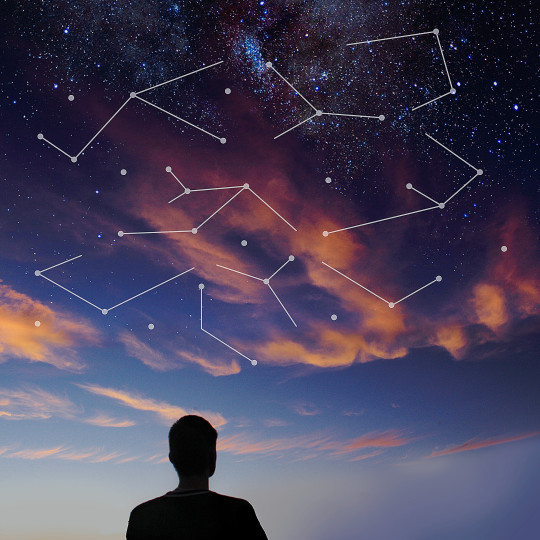
The proper motion of stars across the celestial sphere, which is the result of their movement through the Milky Way, renders many of the constellations unrecognisable.
1 million years
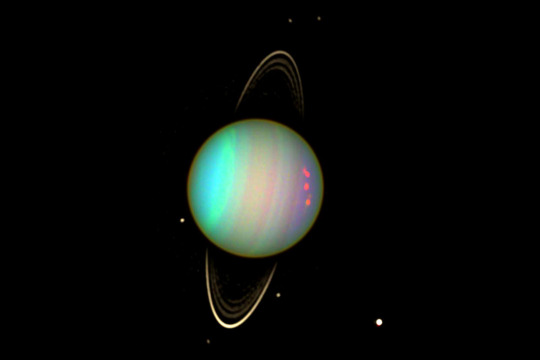
Desdemona and Cressida, moons of Uranus, will likely have collided.
50 million years
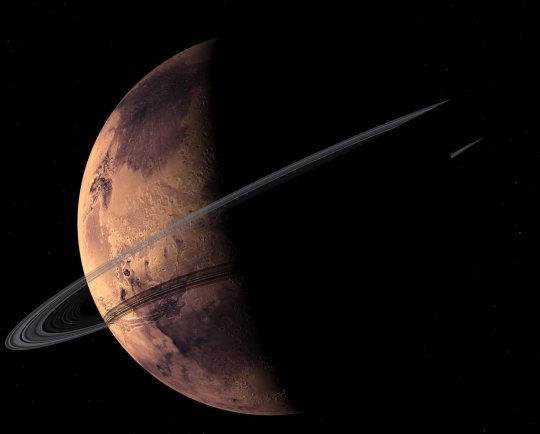
Maximum estimated time before the moon Phobos collides with Mars.
600 million years
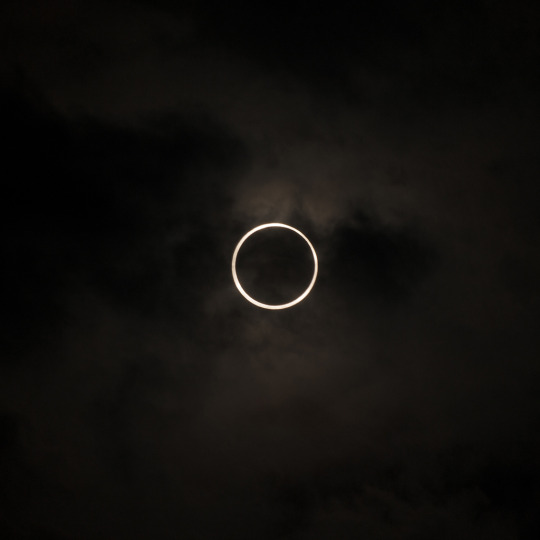
Tidal acceleration moves the Moon far enough from Earth that total solar eclipses are no longer possible.
3 billion years
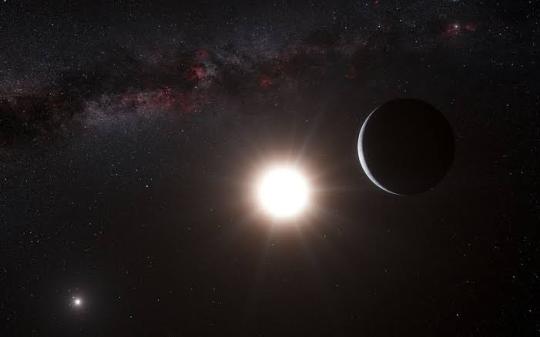
There is a roughly 1-in-100,000 chance that the Earth might be ejected into interstellar space by a stellar encounter before this point, and a 1-in-3-million chance that it will then be captured by another star. Were this to happen, life, assuming it survived the interstellar journey, could potentially continue for far longer.
3.6 billion years
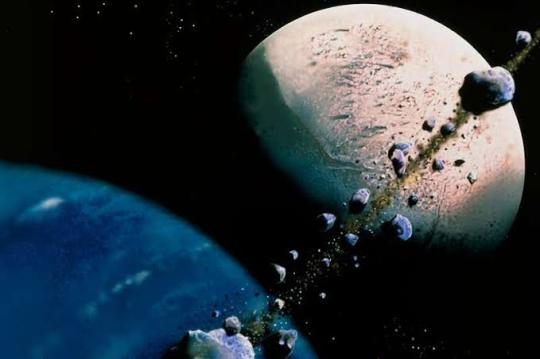
Neptune’s moon Triton falls through the planet’s Roche limit, potentially disintegrating into a planetary ring system similar to Saturn's
4 billion years
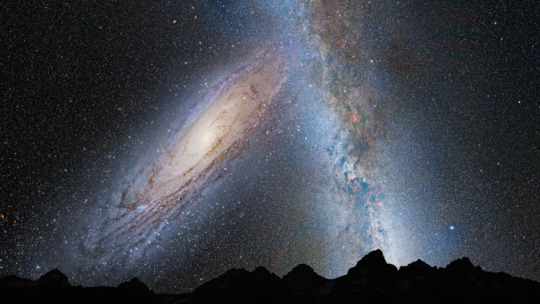
Median point by which the Andromeda Galaxy will have collided with the Milky Way, which will thereafter merge to form a galaxy dubbed “Milkomeda”. The planets of the Solar System are expected to be relatively unaffected by this collision.
5.4 billion years
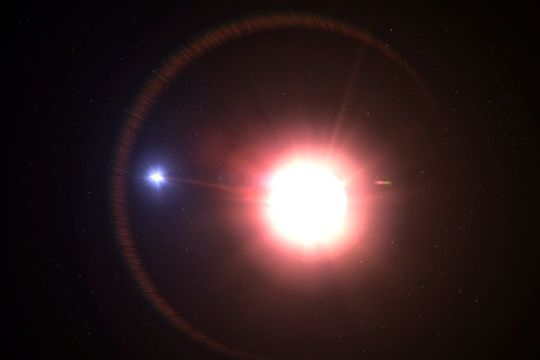
With the hydrogen supply exhausted at its core, the Sun leaves the main sequence and begins to evolve into a red giant.
7.59 billion years
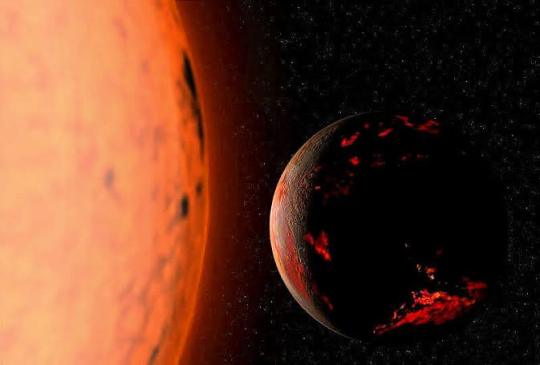
The Earth and Moon are very likely destroyed by falling into the Sun, just before the Sun reaches the tip of its red giant phase and its maximum radius of 256 times the present-day value. Before the final collision, the Moon possibly spirals below Earth's Roche limit, breaking into a ring of debris, most of which falls to the Earth’s surface. During this era, Saturn’s moon Titan may reach surface temperatures necessary to support life. 7.9 billion years: The Sun reaches the tip of the red-giant branch of the Hertzsprung–Russell diagram, achieving its maximum radius of 256 times the present-day value. In the process, Mercury, Venus, and very likely Earth are destroyed.
100-150 billion years
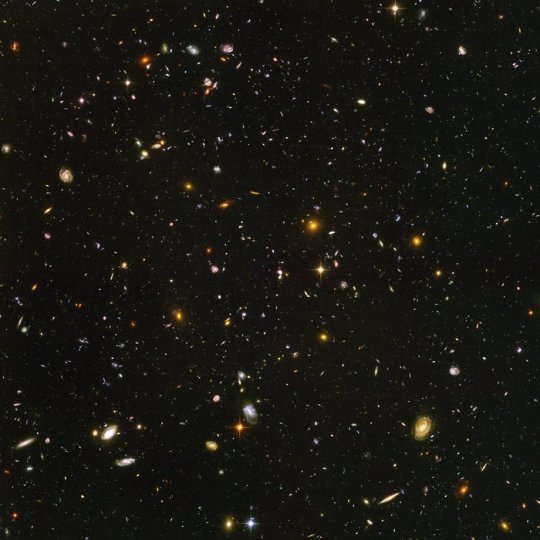
The Universe’s expansion causes all galaxies beyond the former Milky Way’s Local Group to disappear beyond the cosmic light horizon, removing them from the observable universe.
800 billion years
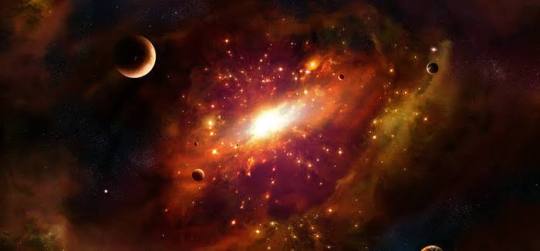
Expected time when the net light emission from the combined “Milkomeda” galaxy begins to decline as the red dwarf stars pass through their blue dwarf stage of peak luminosity.
1014 (100 trillion years)

High estimate for the time until normal star formation ends in galaxies. This marks the transition from the Stelliferous Era to the Degenerate Era; with no free hydrogen to form new stars, all remaining stars slowly exhaust their fuel and die.
1030 years
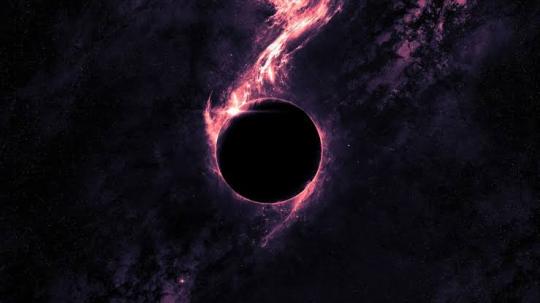
Estimated time until those stars not ejected from galaxies (1%–10%) fall into their galaxies’ central supermassive black holes. By this point, with binary stars having fallen into each other, and planets into their stars, via emission of gravitational radiation, only solitary objects (stellar remnants, brown dwarfs, ejected planetary-mass objects, black holes) will remain in the universe.
2×1036 years
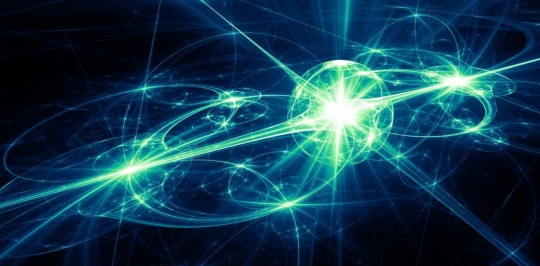
Estimated time for all nucleons in the observable universe to decay, if the hypothesized proton half-life takes its smallest possible value (8.2×1033 years).
5.8×1068 years
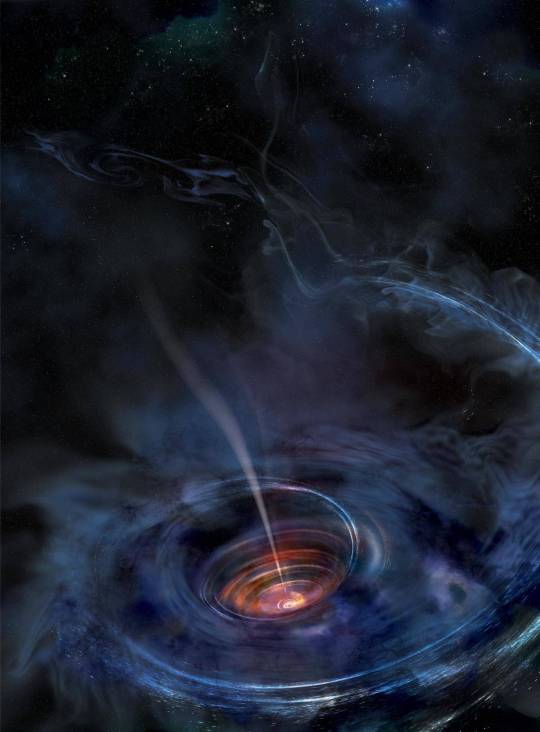
Estimated time until a stellar mass black hole with a mass of 3 solar masses decays into subatomic particles by Hawking radiation.
10^10^10^68 years
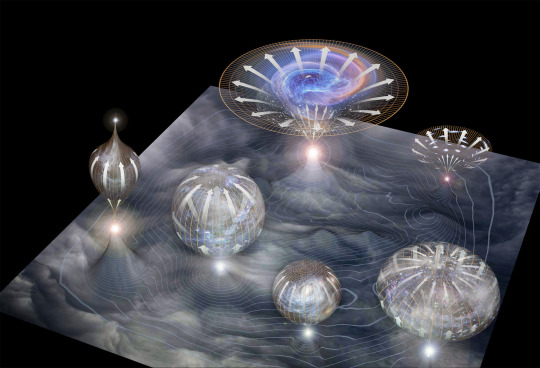
Around this vast timeframe, quantum tunnelling in any isolated patch of the vacuum could generate, via inflation, new Big Bangs giving birth to new universes.
Because the total number of ways in which all the subatomic particles in the observable universe can be combined is 10^10^150 a number which, when multiplied by10^10^10^56, disappears into the rounding error, this is also the time required for a quantum-tunnelled and quantum fluctuation-generated Big Bang to produce a new universe identical to our own, assuming that every new universe contained at least the same number of subatomic particles and obeyed laws of physics within the range predicted by string theory.
(source)
8K notes
·
View notes
Text

The North Star by Sydney Laurence (1865-1940).
483 notes
·
View notes
Text

Winter Night, Adolf Kosárek, 1857
To those in the Northern Hemisphere, happy Winter Solstice.
2K notes
·
View notes
Text

The December night is long and cold but Christmas is almost here. Värmland, Sweden (December 10, 2021).
1K notes
·
View notes
Text

“Out of damp and gloomy days, out of solitude, out of loveless words directed at us, conclusions grow up in us like fungus: one morning they are there, we know not how, and they gaze upon us, morose and gray. Woe to the thinker who is not the gardener but only the soil of the plants that grow in him.” ~ Friedrich Nietzsche
@sweet-harmony
26 notes
·
View notes
Text

…the fog is falling in the park…it's better to go home…
@sweet-harmony
20 notes
·
View notes
Text

And, somewhere
Out there
Just past the Moon
Is where
They be
And, I wonder if
Only in our dreams
Shall we see them
Only in our dreams
Shall they, forever be..🪄
A little poem written by Athey Thompson
Taken from A Little Book of Poetry by Athey Thompson
Art Unknown
Tales of the old Forest Faeries
369 notes
·
View notes




